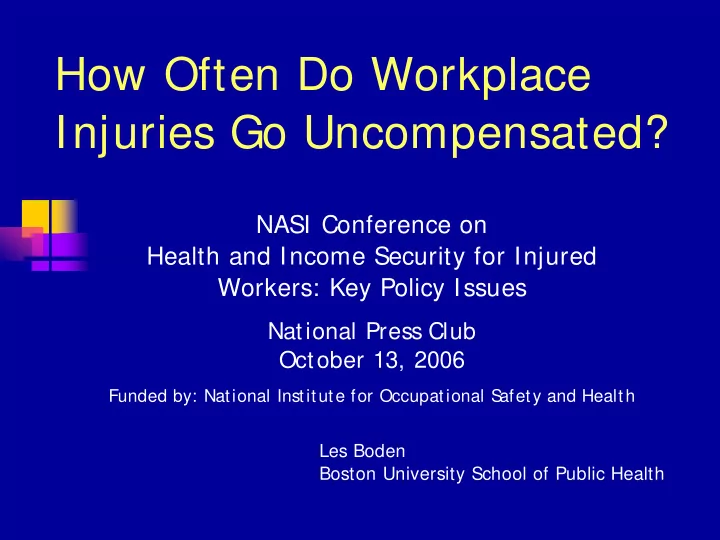

How Often Do Workplace Injuries Go Uncompensated? NASI Conference on Health and Income Security for Injured Workers: Key Policy Issues National Press Club October 13, 2006 Funded by: National Institute for Occupational S afety and Health Les Boden Boston University School of Public Health
Income Maintenance for Injured Workers � Workers’ comp is main source of replacement for lost earnings � Those who do not get WC are harmed financially � Employer safety incentives are reduced � Reported # and cost of work-related injuries declines, so public prevention efforts appear less important
Factors Affecting WC Filing � Knowledge of WC entitlement � Stigma – fraud & malingering � Expected benefits – claim acceptance, benefit levels & medical care coverage � WC hassle � Employers’ attitudes & policies � Concerns about job security � Illegal immigrants – fear of deportation
Capture-Recapture Analysis � Uses information on individual reporting to multiple sources: � By linking individual reports, find cases reported to both sources and reported to one but not the other � Given certain assumptions, can estimate the number of cases reported to neither � Calculate the number of unreported cases (uncompensated injuries)
Data Sources for this Study � Bureau of Labor Statistics Annual Survey of Injuries and Illnesses � Stratified probability sample of employers � For each days-away-from-work case: worker, employer and injury characteristics � State Workers’ Comp Databases � All lost-time injuries should be reported � Injury and worker characteristics reported
Method Assumes Independence of Reporting � Reporting likely to be positively correlated � Doctor doesn’t diagnose (esp. disease) � Worker doesn’t report an injury � Employer doesn’t think it’s work-related � = > Injury estimates are better than reports, but still below true number � Also assumes no over-reporting
What We Did Collect BLS and WC injury data � Match individual injury records � Determine comparable � employer/injury samples BLS sampled employers � Duration over waiting period � Estimate how many injured workers � don’t get WC benefits
Participating States � Minnesota � West Virginia � New Mexico � Wisconsin � Oregon � California: just beginning � Washington
Percent of Workplace Injuries Compensated 1998-2001 Source Independence (Odds Ratio= 1) WA* WV* OR* WI* NM# MN* 94% 91% 78% 73% 66% 63% * 3-day waiting period # 7-day waiting period Preliminary results: Final results available 12/06
Percent of Workplace Injuries Compensated 1998-2001 Impact of Source Dependence Odds Ratio WA* WV* OR* WI* NM# MN* 1 94% 91% 78% 73% 66% 63% 5 85% 85% 58% 55% 46% 45% * 3-day waiting period # 7-day waiting period Preliminary results: Final results available 12/06
Implications for WC � Adequacy of benefits: Replacement Rate= 0 for 6% to 37% (or 15%-55%) of injuries � Safety incentives reduced as well � Undercompensation may be concentrated among already marginal workers
Conclusions � Under the most conservative assumptions, in 4 of 6 states less than 80% of injured workers receive WC. � Using less conservative assumptions, in 4 of 6 states less than 60% of injured workers receive WC.
Important Questions Remain � Can we identify the most important factors? For example: � State WC laws � Employer policies � Stigma of WC claim � What is the impact on injured workers not receiving WC benefits?
Thanks for Help Cooperating States � Funding: NI OSH � Bill Kahley, Christine Baker BLS � � and Liza Dizon (CA) Tony Barkume � Teri Van Hoomissen & Brian � Jim Barnhardt � Zaidman (MN) Brooks Pierce � Mark Llewellyn & Tom � Terry Burdette � Dauphinee (NM) Jim Spletzer � Ed Bissell & Mike Maier (OR) � John Bishow � Amy Lee and Xiaohua Lu � Boston University (TX) � Steve Evans Barbara Silverstein, Heather � � Grob & Bill Blanford (WA) Al Ozonoff � Lee Shorey & Duane Frisch Greg Howard � � (WI) Clark U :Wayne Gray � Syed Islam & Ed Doyle (WV) �
Recommend
More recommend